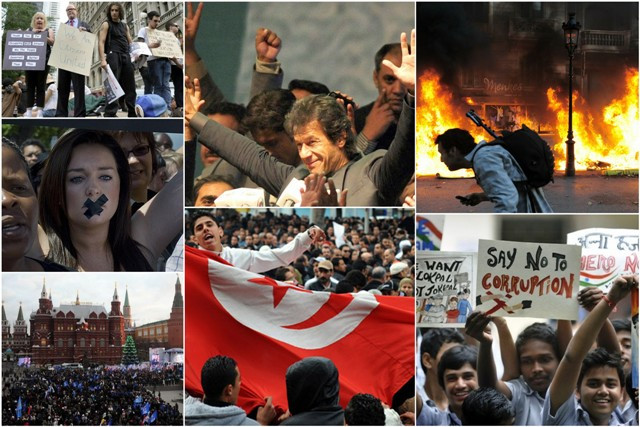When a Tunisian fruit vendor set himself on fire in late 2010, he ignited a mass protest movement across his country. What Mohamed Bouazizi likely never expected, however, is that the uprising would be followed by many others worldwide.
With 2011 drawing to a turbulent close, now is an opportune time to highlight the ten most notable protests and political movements of the last year.
Tunisia protests: Removing President Zine el-Abidine Ben Ali from power is only part of the story. Remarkably, notwithstanding isolated demonstrations against the new government’s failure to prosecute the ousted president’s supporters, Tunisia has enjoyed a relatively smooth transition toward democracy. Contrast this with Egypt, Yemen, Libya, and Syria; where the early flowerings of Arab Springs wilted into brutal state crackdowns or civil war.
The Imran Khan phenomenon. Khan’s dramatic rise defiantly rebuts those who argue Pakistan is too divided, unsafe, or locked into the patronage-dominated status quo to produce a mass movement for change. His massive Karachi rally squelched any talk about Lahore being a fluke, and his intention to hold another jalsa in Quetta, the capital of Pakistan’s most-ignored province, suggests a genuine willingness to be inclusive. While his election prospects remain uncertain, his growing appeal is undeniable.
India’s anti-corruption movement. India is so beset by corruption, according to prominent strategist Brahma Chellaney, that it poses an existential threat. Back in December 2010, Chellaney wrote that India may require “a second war of independence” to rid itself of the scourge. The mass protests that convulsed India over the next year did not go so far, though they did help produce a milestone anti-graft bill.
Occupy Wall Street. Contrary to its proclamations of “exceptionalism,” America suffers from the same inequality and corporate malfeasance that prevail elsewhere. This movement’s popular “we are the 99 percent” rallying cry finally forced US politicians to acknowledge that these problems resonate with large majorities of Americans. The movement also revealed that American progressives’ grievances about Washington’s excesses echo those of Tea Party conservatives, despite sharp disagreements on social issues.
Anti-austerity protests in Europe. European governments have long provided generous social benefits. Yet with their populations aging, and the needs of the elderly consuming ample state resources, this social spending has become prohibitive, necessitating cuts, particularly to education, that affect youth. Unrest across Great Britain, Greece, and Spain heralds a volatile new reality for Europe: one produced by the convergence of shifting demographics, youth’s shattered expectations, and economic realism.
Unrest in Chile. Chile is a political and economic success story in a region long dominated by political strongmen and economic distress. In recent times, the nation has celebrated as its status changed from developing to developed nation. Yet in 2011, young people, furious about high-interest student loans and other costly aspects of education, took to the streets, reminding the world that all is not well in Chile.
“Black Tuesday” in South Africa. A Tuesday in 2011 marked the passing of controversial legislation deemed the “Secrecy Act,” with critics lambasting it as something worthy of the apartheid era. The subsequent protests sent a resounding message that South African society has no interest in revisiting the politics of that terrible period. Masses of multiracial citizens representing a variety of professions, demonstrated in droves calling for the law to be overturned.
Monks’ defiance in Burma. Several years ago Burma enjoyed a hopeful, yet short-lived, period of peaceful protest. This year, five monks staged a modest demonstration in a temple, calling for the release of political prisoners. In a closed state like Burma, such isolated demonstrations are freighted with importance. With the bold act taking place, not long after the state’s liberation of long-detained opposition hero Aung San Suu Kyi, it gives hope that the junta will loosen, even if modestly, its tight grip on power.
Rallies in Russia. Many forget the unfortunate similarities; corruption, unemployment and ossified leadership shared between Russia and the Arab Spring nations. For much of 2011, there was little reason to make the connection, until just last week, when Russians converged on the capital. The significance of these protests lies not in their expected outcomes (few anticipate Vladimir Putin to disappear), but in their numbers; not since the fall of the USSR have so many Russians taken to Moscow’s streets.
Uprisings in China’s countryside. Chinese officials have long been preoccupied by protests in the hinterland. This year, however, was particularly active with land seizures a major trigger, and particularly in the village of Wukan, where officials agreed just days ago to address demonstrators’ demands. This signifies China’s new desire to contain protests before they can spread; surely a lesson learned from the events of 2011.
10 notable protests, political movements of 2011
With 2011 over, now is an opportune time to highlight the 10 most notable political movements of last year.



COMMENTS
Comments are moderated and generally will be posted if they are on-topic and not abusive.
For more information, please see our Comments FAQ